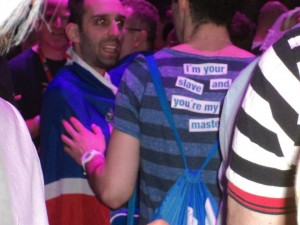Mixed Media Creative Essay
by Maria Konidaris, s3434412
Eurovision is a complex system in its own right, as described by Watts (2003), ‘the parts involved in its makeup do not sum up in any simple fashion, rather, they interact with each other and in interacting, even quite simple components can generate bewildering behaviour. Some components, to name include the intercontinental participation networks such as press, blogs, social media and the OGAE fan base.
The Eurovision Song Context began in 1956 in Switzerland. With the introduction of commercial television in a time where international relations in Europe were poor due to preceding years of war (and ongoing civil wars), it was very much a social experiment in live broadcasting and joining countries together in a wide-are international network. The basis of participation is that the country must be a part of the European Broadcasting Union (EBU) and in 1956, seven countries competed in the first ever Eurovision. Voting, took place by a jury which contained representatives from each participating country.
Limitations and previously used structures implemented in the contest that have been no longer described or changed significantly were all ultimately due to Eurovision’s growth, advances in technology and in level of participation. In its early years roughly a dozen countries participated, it was broadcast live only on television and the jury voting system was being updated constantly to reduce negative bias. Countries out of Europe did not broadcast the contest as 1) None of them participated; the European Broadcasting Union (EBU) was still in its formative stages and had a lot less members and 2) European immigrants living overseas due to financial struggles were still settling in their new countries and had little influence over the media demand and born citizens with no ties to Europe would have had less exposure to entertainment media on the other side of the world.
In 2014, Eurovision had over 30 participating countries and was broadcast all over the world as a fan base in other continents has since been generated. The changes in ease of international travel, broadcast and the internet have played a large role in this expansion and the ways in which Eurovision-related media is made as well as consumed.
Strength of social ties between countries, in particular neighbouring countries is very important to the outcome of voting results for example in voting, Scandinavian countries seem to favour their own and distribute higher scores amongst their neighbours, the same can be said for the Ex-Soviets, Balkans, Greece with Cyprus, Italy with San Marino etc
Negative social ties have been reported to affect voting outcomes for example with people from countries such as Albania, claiming their low scores were generated on purpose out of racial discrimination from other countries. These types of claims however, are often made by the uninformed general public as they are mostly reported on informal platforms such as comment sections of research articles or videos. The demographically-balanced, professional voting jury has been used since the beginning to reduce bias and currently it makes up 50% (televoting making up the other half) of the total scores presented. A recent scientific study based on the statistical analysis of voting patterns since televoting was first introduced in 1998 and also dismisses these negative claims as results showed that, ‘negative bias was virtually invisible in the study: no country systematically gives any other low points, meaning there is no evidence of prejudice or discrimination against anyone. Even in the case of Albania, which was consistently relatively unpopular in the voting, the effect was very small and the authors did not consider this to statistically demonstrate a negative bias’ (Baio, 2014).
Advances in technology have significantly enhanced Eurovision as even the contest itself began as a kind of television broadcast experiment. Improvements in telephony and a proposition for more audience participation resulted in the introduction of tele-voting in 1998, a move which very much, in both my personal opinion and the generally more popular one, revolutionised the Eurovision Song Contest for the better. This signified the beginning of Eurovision as an event wherein its followers are more than simple viewers or consumers and acknowledges in support, modern media influence theories that regard the role of the audience as an active one. The massive, Organisation Générale des Amateurs de l’Eurovision (OGAE) network, which includes myself as a member, consists of 40 fan clubs around the world and is a testament to this idea. It was founded before tele-voting, in 1984 in Finland by Jari-Pekka Koikkalainen, now an honorary member of OGAE Finland, and it was first decided to become a formal legal entity in 2002, finalised under French law in 2011.
Each year OGAE International is responsible for distributing fan-tickets, which are generally the best front-row seats in the three main ESC-concerts (semifinals and Final). Annually OGAE International also hosts three music contests, which aim to promote national popular music throughout all the local OGAE-clubs and to increase co-operation through the network of clubs. Naturally OGAE also aims to develop the Eurovision Song Contest itself while establishing strong relationships with both the European Broadcasting Union (EBU) and the organising broadcasting companies. Each local club also aims to work in co-operation with their respective national broadcasting company in order to work together in the national pre-selection events.
The OGAE network is just one example of how the coming together of fans impacts Eurovision as a whole. Their collective behaviour is what makes up a large part of the live audience and atmosphere, they’re even known to distribute supportive fan paraphernalia and are actively working towards being more involved with national selection processes. Social media users, especially Eurovision bloggers and Twitter users are another example.
Since the emergence of the world wide web, Eurovision has been available for live streaming and recordings from contests since the 50s have been stored to be easily accessible at all times. Gitelman (2008) illustrates this importance in stating, ‘Like old art, old media remain meaningful’ as how far Eurovision has come is both indicative of sociopolitical, cultural and technological development and a document of a colourful history which may potentially lead to a colourful future. The internet has not only allowed for increased exposure on a global scale but for fans or any ‘media-makers’ to access the content for re-presentational or even research purposes. On a spectrum, one side to this is that it has allowed for the sceptic, political and negative perspectives to be published and exist in the public however the positive is other than another avenue of support is the appreciation of minor details that comes with actions such as creating a 5 second GIF and re-modelling aspects to display a different angle- such as satire, a strong example being a Moldovan performer from 2009 who has gained so much popularity over blogs and social media that they are now the first result after searching only ‘sax guy’ on Google. The audience is more highly regarded than ever as national broadcasters, even here in Australia SBS, encourage hashtags on twitter during the event and it was only recently in 2011 that it was decided that audience voting make up 50% of scores. Voting is now completed over the phone, over the internet and over applications.
In analysing the Eurovision Song Contest it can easily be considered a dynamic, complex network because within it, occurrences aren’t happening at random but instead because the networks themselves are evolving and changing in time; it is driven by activities or decisions of its components (Watts, 2003). Advancements and increasing participation have altered the competition for the better thus far (the most expensive contest was this year’s in Copenhagen), one can only imagine what the continuous development of technology and collectivity of a new generation of people will mean for the future.
References
Baio, G. Blangiardo, M. 2014. Evidence of bias in the Eurovision song contest: modelling the votes using Bayesian hierarchical models. Journal of Applied Statistics. Taylor and Francis: UK. retrieved from < http://www.tandfonline.com/doi/full/10.1080/02664763.2014.909792#.VEivektbylI>
Barabási, A. 2002. Linked: The New Science of Networks. Perseus: Cambridge (MA)
Clerides, S. 2012. Love thy Neighbor, Love thy Kin: Strategy and Bias in the Eurovision Song Contest Ekonomia: Cyprus 15.1: 22-44. retrieved from <http://works.bepress.com/sofronis_clerides/11>
Gitelman, L. 2008. Always Already New: Media, History, and the Data of Culture. Cambridge, Mass; London
Watts, D. 2003. Six Degrees: The Science of a Connected Age. Vintage: London
Other References
OGAE International: http://www.ogaeinternational.com/index.php?option=com_content&view=article&id=46&Itemid=53
Brief article on voting bias: http://www.ucl.ac.uk/news/news-articles/0514/020514-eurovision-voting
Poll from http://www.euronews.com/2012/05/21/eurovision-the-great-voting-conspiracy/




